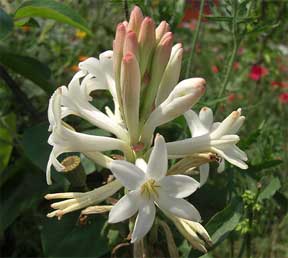The Tuberose (pronounced TU ber oze, not TUBE rose) should present no great problem to the garden landscaper if you remember that it is a Mexican plant accustomed to warm and hot temperatures and that it belongs to the amaryllis family which includes members that are very particular about the depth of their noses.
Bulbs are offered in spring catalogs. They may be described under their botanical name, Polianthes tuberosa, or the double one as ‘Double Pearl’. The single one with plain green foliage is usually listed as Mexican tuberose; the one with white-edged leaves as ‘Speciosa.’ The double form is slower to come into bloom than the single but is most beautiful. All have waxy white, very fragrant blossoms.

You will receive single divisions and may note that the bulb-like tuberous rootstock is covered with the broadened bases of its withered leaves, perhaps with offsets showing at the base of the bulb. When danger of frost is past and the soil warm, plant the bulbs in a sunny, well-drained location. They prefer sandy soil enriched with well—rotted manure.
Cover the noses with a scant inch of soil. If rainfall is normal, they require no more attention except shallow cultivation. In drier areas or during prolonged drought. water them well, and when the soil is soaked, mulch the ground carefully with rotted straw, or some other material to conserve moisture.
The narrow leaves form a rosette like growth and in time are 12 to 18 inches long making a neat and attractive clump of green. The straight unbranched bud stems rise two to three feet high, topped by clusters of single or double blossoms in August. Later stems may continue to open blossoms until blackened by a hard freeze.
Tuberoses may be planted near roses since they like similar conditions or among hemerocallis or other sun loving plants. Spaced some three feet apart, they are striking along a driveway when plants of portulaca with large crimson blossoms are planted between the clumps.
The flowers last well when cut. Combine them with pale yellow hems or light colored marigolds. They can be used with flowers that lack a pleasant odor. Most people delight in the incomparable fragrance of the tuberose although a few find it almost overpowering in a closed room. Plant a few clumps near the house where the exotic perfume may waft in on a night breeze through open windows.
Tuberoses multiply rapidly and can be kept over successfully year after rear. Light frost will tend to mature the foliage but plan to dig them before a hard freeze can do any damage. They lift with little effort. You will find them much easier to dig than cannas or calla lilies.
If, subsequently, they fail to bloom the trouble can be in the way they are stored. After digging, leave the clumps intact with the soil clinging to the bulbs. If the weather is dry and the temperature above freezing, they may be left outside or piled in an airy shed for a few weeks to dry. Then cut away the foliage and pack the clumps closely together in boxes lined with waterproof material. Store in a warm basement or in an unused room where the temperature does not fall below 60 or 50 degrees.
Sprinkle them ever so lightly occasionally during the winter. The tips should remain green and firm but it takes very little moisture to keep them in this condition. Too much moisture and cold may cause rotting.
